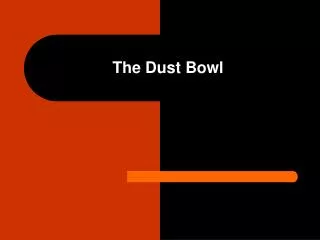The Dust Bowl
Explore the causes and effects of the Dust Bowl crisis in the 1930s, affecting states like Texas, with severe droughts leading to ruined crops, livestock loss, and economic hardship. Witness the struggles faced by families through vivid images.
Share Presentation
Embed Code
Link
Download Presentation

schwartz + Follow
Download Presentation
The Dust Bowl
An Image/Link below is provided (as is) to download presentation Download Policy: Content on the Website is provided to you AS IS for your information and personal use and may not be sold / licensed / shared on other websites without getting consent from its author. Content is provided to you AS IS for your information and personal use only. Download presentation by click this link. While downloading, if for some reason you are not able to download a presentation, the publisher may have deleted the file from their server. During download, if you can't get a presentation, the file might be deleted by the publisher.
Presentation Transcript
- The Dust Bowl Grade 4 Social Studies Unit: 10 Lesson: 02
- The Dust Bowl: 1930s • The Dust Bowl was an area of the country that was affected by drought in the 1930s, with 1934-1936 being the most severe. • The states most affected were Wyoming, Montana, North and South Dakota, Nebraska, Kansas, Oklahoma, Colorado, New Mexico, and Texas.
- Image Source: http://www.fasttrackteaching.com/burns/Unit_9_1930s/Unit9_Dust_Bowl.html
- The Dust Bowl: 1930s • The area most affected in Texas was the panhandle. • Cities such as Dalhart, Amarillo, Lubbock, Midland, Odessa and the small communities surrounding them were heavily impacted.
- The Dust Bowl: 1930s Causes: • Severe drought (no rain) • High winds and temperatures well over 100 degrees. • Farming methods at that time did not use ground cover, crop rotation, or soil conservation methods. • The result was that the dry conditions and high winds caused the soil to turn to dust and blow away.
- The Dust Bowl: 1930s Effects: • Severe dust storms or “black blizzards” devastated communities. • Crops were ruined. • Livestock perished. • Family farms were lost.
- The Dust Bowl: 1930s Effects: • Adults and children died from dust pneumonia. • Children wore dust masks walking to school. • Homes were overcome with insects and pests such as scorpions, spiders, rattlesnakes. • Thousands of jackrabbits devoured family gardens.
- The Dust Bowl: 1930s Effects: • Acts of daily life such as breathing, eating, and working were no longer simple. • Children wore dust masks to and from school. • Women hung wet sheets over windows in a futile attempt to stop the dirt from entering their homes. • Farmers watched helplessly as their crops and land blew away.
- The Dust Bowl: 1930s • West Texas was hit the hardest, but people all over the state were hurt economically during these years.
- Pretend you are one of the children in this picture. Write one word describing how this makes you feel. Arthur Rothstein, photographer, April, 1936. (Library of Congress) Source: http://www.weru.ksu.edu/new_weru/multimedia/dustbowl/dustbowlpics.html
- Describe the picture below. What similar experiences come to mind? (Western History Collection, University of Oklahoma) Source: http://www.weru.ksu.edu/new_weru/multimedia/dustbowl/dustbowlpics.html
- Explain in a sentence why these severe dust storms were called “black blizzards.” A black blizzard over Prowers Co., Colorado, 1937. (Western History Collection, University of Oklahoma) Source: http://www.weru.ksu.edu/new_weru/multimedia/dustbowl/dustbowlpics.html
- What do you think happens inside the houses when a dust storm like this hits? Dust storm approaching Stratford, Texas Dust bowl surveying in Texas Image ID: theb1365, Historic C&GS Collection Location: Stratford, Texas Photo Date: April 18, 1935 Credit: NOAA George E. Marsh Album Source: http://www.weru.ksu.edu/new_weru/multimedia/dustbowl/dustbowlpics.html
- Why would the severe drought hurt cattle and other animals? Arthur Rothstein, photographer, 1936. (Library of Congress) Source: http://www.weru.ksu.edu/new_weru/multimedia/dustbowl/dustbowlpics.html

The Dust Bowl
The Dust Bowl. 1931. Drought in Midwest and Plains Black blizzards over plowed land. 1933. From 14 dust storms in 1932 to 36 in 1933 Franklin D. Roosevelt takes office Banks take four day holiday Government gives $200 million to banks to give loans to farmers in need
425 views • 10 slides

The Dust Bowl
The Dust Bowl. The Dust Bowl > Dust Storm. A wall of dirt and sand descends upon Spearman, Texas, on August 14, 1935. The Dust Bowl > Dust Storm Approaching Startford, Texas, 1930s. The Dust Bowl > Pare Lorenz, The Plow That Broke the Plains , 1936.
435 views • 17 slides

The Dust Bowl
The Dust Bowl. For eight years dust blew on the southern plains. It came in a yellowish-brown haze from the South and in rolling walls of black from the North. The simplest acts of life — breathing, eating a meal, taking a walk — were no longer simple.
237 views • 9 slides

The dust bowl
The dust bowl. By t-dogg. The cause.
263 views • 7 slides






